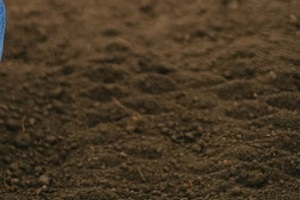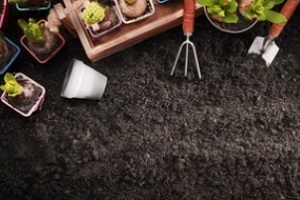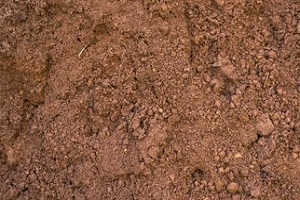 The right dirt is the key to a healthy garden, and topsoil plays a vital role in the ultimate success of whatever you plant. Because plants depend on the topsoil for water and nutrients, it is important to ensure the uppermost layer of your dirt is full of organic matter. In addition to supporting plant growth, this type of soil tends to be quite easy to dig in, making the gardening process more enjoyable.
The right dirt is the key to a healthy garden, and topsoil plays a vital role in the ultimate success of whatever you plant. Because plants depend on the topsoil for water and nutrients, it is important to ensure the uppermost layer of your dirt is full of organic matter. In addition to supporting plant growth, this type of soil tends to be quite easy to dig in, making the gardening process more enjoyable.
However, many people do not have decent topsoil in their yard. A good topsoil tends to be very dark in color thanks to the presence of a high amount of organic matter. If your yard falls short, you are not alone. For most people, the quality of soil surrounding their home is not ideal for plants.
This is particularly true for newly constructed homes as topsoil is often removed from yards during construction, and it takes time to build up a good-quality soil with the right amount of decomposed plants and organic matter. Those who live in mountainous or rocky areas may find that they do not have any topsoil at all in their yard.
How to Obtain Good Topsoil
The quickest way to get good-quality topsoil in your garden is by purchasing it. This is a good investment because you can ensure that you are getting topsoil that boasts qualities such as an ability to retain the right amount of water, good drainage, and the loose texture that is needed to facilitate digging.
It is important to keep in mind that topsoil is not the same thing as fill dirt. When you are shopping for dirt, you will probably find options in both categories, but they are not interchangeable.
Make sure you always go for topsoil as fill dirt is not suitable for planting. This is the dirt that sits below the topsoil, and it tends to be rockier and contain a lower amount of organic material. Topsoil is typically placed on top of fill dirt. Because of topsoil’s greater amount of organic matter, it is more likely to break down as air pockets collapse. Therefore, topsoil is only considered appropriate for the top layer of landscaping and is placed on top of fill dirt once it has been set.
How Much Topsoil Do I Need?
 Although you can find topsoil at home improvement centers and garden stores, one of the most cost-effective ways to bring in a significant amount of topsoil is by buying it in bulk from construction companies such as Dirt Connections.
Although you can find topsoil at home improvement centers and garden stores, one of the most cost-effective ways to bring in a significant amount of topsoil is by buying it in bulk from construction companies such as Dirt Connections.
The amount that you need to buy will depend on how you intend to use the land where you are placing the soil. For example, a vegetable garden will need around 12 inches of topsoil, while raised beds require 18 inches of topsoil. Lawns just need around six inches of topsoil, and you will only need a couple of inches if you are adding topsoil onto an existing lawn.
When purchasing topsoil by the truckload, you will often be quoted prices by the cubic yard. One cubic yard of topsoil equals 27 cubic feet. However, you need to know how deep you will be placing the topsoil before you can determine how far one yard of topsoil will go.
For example, if you plan to spread your topsoil 12 inches thick for a vegetable garden, one yard of topsoil will only cover about half as much ground as it would if you are only spreading a layer 6 inches thick.
Although there are online topsoil calculators online to help you determine the amount you need, you can also use a simple formula to make your own calculations.
Calculating the Cubic Yards of Topsoil You Need
Use the following formula to determine how many cubic yards of topsoil you will need:
Square feet multiplied by soil depth = cubic feet
Cubic feet divided by 27 = cubic yards
Here are three steps for getting the number you need.
1. Measure the length and width of the area where you will be placing the topsoil and multiply them together. For example, if your vegetable garden measures 10 feet by 40 feet, you will need your topsoil to cover 400 square feet.
2. Multiply the square footage we determined in step one by the depth, in feet, at which you intend to lay the topsoil to determine the cubic feet. Since we are talking about a vegetable garden in our example, you will want to lay it around 12 inches deep. Since 12 inches equals 1 foot, you just need to multiply your square foot calculation by one in this case. 400 square feet times 1 foot equals 400 cubic feet.
3. Because there are 27 cubic feet in a cubic yard, you’ll need to divide the 400 cubic feet we obtained in Step 2 by 27. The result is 14.8. This means that you will need 14.8 cubic yards of topsoil if you want to apply a 12-inch layer to a 10-by-40-foot garden bed. However, it is a good idea to round up and purchase 15 cubic yards so that you’ll have some extra to account for erosion.
How Much Does One Yard of Topsoil Weigh?
 This is a commonly asked question, but it is a difficult one to answer because the weight of a yard of topsoil will vary depending on how damp the soil is. Damper soil that holds more water will naturally weigh more than drier topsoil. A yard of topsoil can range in weight from 1500 to 3000 pounds.
This is a commonly asked question, but it is a difficult one to answer because the weight of a yard of topsoil will vary depending on how damp the soil is. Damper soil that holds more water will naturally weigh more than drier topsoil. A yard of topsoil can range in weight from 1500 to 3000 pounds.
However, when you order topsoil from companies such as Dirt Connections, you do not need to worry about determining the weight of the soil because we will deliver it directly to your garden. so there is no need to worry about the capacity of your truck.
Talk to the Soil Experts at Dirt Connections
If you need help planning your garden or calculating the amount of topsoil you need, get in touch with the soil experts at Dirt Connections. We will be happy to answer your questions and can arrange to deliver topsoil to your home or construction site in and around the Northern Virginia area.
Summary

Dirt Connections was started with one goal in mind: providing quality residential and commercial construction services to clients on time and on budget. Reach out for more information on how we can support your next project.
For your convenience our estimates are free and by appointment. Call 703-940-9949 for a free estimate today!









































